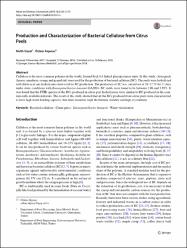| dc.contributor.author | Güzel, Melih | |
| dc.contributor.author | Akpınar, Özlem | |
| dc.date.accessioned | 2019-12-16T13:48:03Z | |
| dc.date.available | 2019-12-16T13:48:03Z | |
| dc.date.issued | 2019 | |
| dc.identifier.uri | https://hdl.handle.net/20.500.12440/1692 | |
| dc.identifier.uri | https://link.springer.com/article/10.1007/s12649-018-0241-x?utm_source=getftr&utm_medium=getftr&utm_campaign=getftr_pilot | |
| dc.description.abstract | Cellulose is the most common polymer in the world, formed by β-1,4 linked glucopyranose units. In this study, citrus peels
(lemon, mandarin, orange and grapefruit) were used for the production of bacterial cellulose (BC). The peels were hydrolyzed
with dilute acid and hydrolysates were used for BC production. The production of BC was carried out at 28–32 °C for 21 days
under static conditions with Komagataeibacter hansenii GA2016. BC yields were found to be between 2.06 and 3.92%. It
was found that the FTIR spectra of the BCs produced in citrus peel hydrolysates were similar to BC produced in the commercially available nutrients. The result of this study showed that all the BCs produced from citrus peels were characterized
to have high water holding capacity, thin fiber diameter, high the thermal stability and high crystallinity. | en_US |
| dc.language.iso | eng | en_US |
| dc.rights | info:eu-repo/semantics/closedAccess | en_US |
| dc.subject | Bacterial cellulose · Citrus peels · Komagataeibacter hansenii · Waste valorization | en_US |
| dc.title | Production and Characterization of Bacterial Cellulose from CitrusPeels | en_US |
| dc.type | article | en_US |
| dc.relation.publicationcategory | Makale - Uluslararası Hakemli Dergi - Kurum Öğretim Elemanı | en_US |
| dc.department | Meslek Yüksekokulları, Şiran Mustafa Beyaz Meslek Yüksekokulu, Gıda İşleme Bölümü | en_US |
| dc.contributor.institutionauthor | Güzel, Melih | |


















